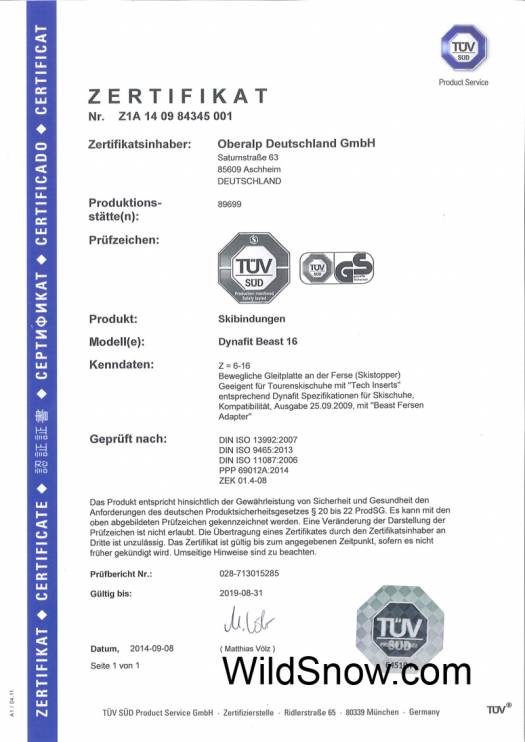(Update: October 2014. We heard from an insider friend in Germany. The TÜV certification shown below, dated Sept 8, 2014, covers all retail versions of Dynafit Beast binding, including the first released in 2013. There was some confusion about this as the date of the cert shown below is much later than the first release of the binding last season. Thus, a lot of people were wondering if it was retroactive or only covered the latest iteration of the binding. See comments for more info. Also please note, for the purpose of best indexing and searching, as well as keyboarding on a smartphone, we will be spelling TÜV both ways, TÜV and TUV.)
I’m in an internet cafe in the Andes, Chile. This Beast 16 info came in from Dynafit, appropriate to get it blogged right away since I know many of you are shopping for “quiver of one” freeride bindings. I’m told Beast 16 is now in retail distribution for this coming winter of 2014/15. More, it received TUV certification to DIN 13992 as of September 8, 2014, thus making Beast one of the only two TUV certified tech bindings “on the market” at the time of this writing. Or to be more precise, meaning Beast 16 is the _only_ DIN 13992 available in retail at this time, with a competitor due for limited retail starting early this winter. Fun to see acceleration of binding innovation and competition. To the benefit of all skiers out there!
Historical note: In 1994 Raichle (then owner of Dynafit brand) did receive TUV certification of the Dynafit TLT binding model to DIN/ISO standard 7891, the ski touring binding standard of that time. Subsequently, standard DIN/ISO 13992 took the place of 7891 and until Beast no Dynafit binding was certified to DIN/ISO 13992. Thus, in terms of “TUV certification” Dynafit could be said to have been first. Nonetheless, in our coverage here we’re concerned with latest active standard, which is 13992. Beast was the second tech binding to receive 13992 certification (by just a few weeks difference from the first, both in 2014).
WildSnow.com publisher emeritus and founder Lou (Louis Dawson) has a 50+ years career in climbing, backcountry skiing and ski mountaineering. He was the first person in history to ski down all 54 Colorado 14,000-foot peaks, has authored numerous books about about backcountry skiing, and has skied from the summit of Denali in Alaska, North America’s highest mountain.


